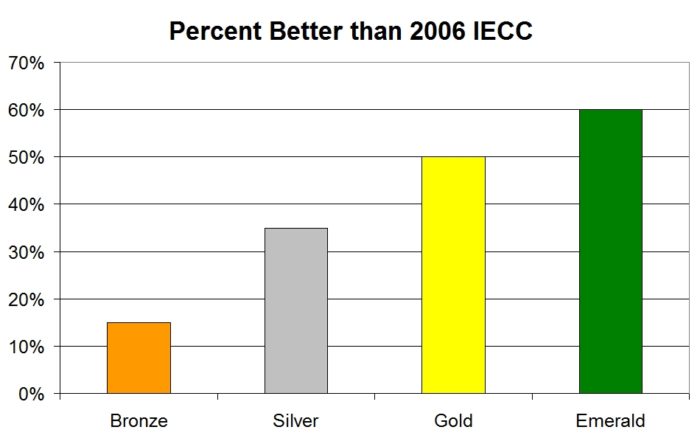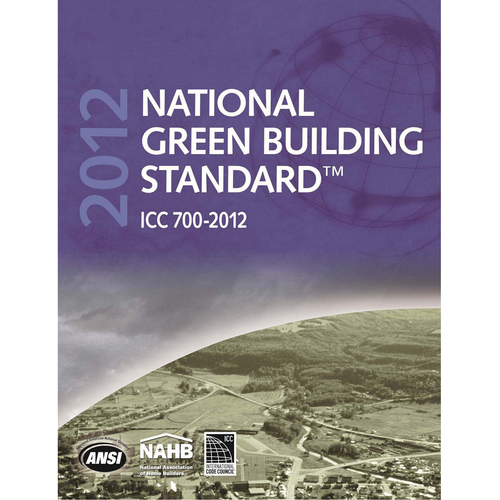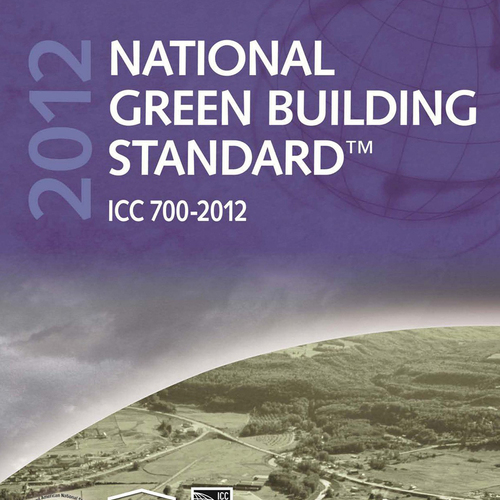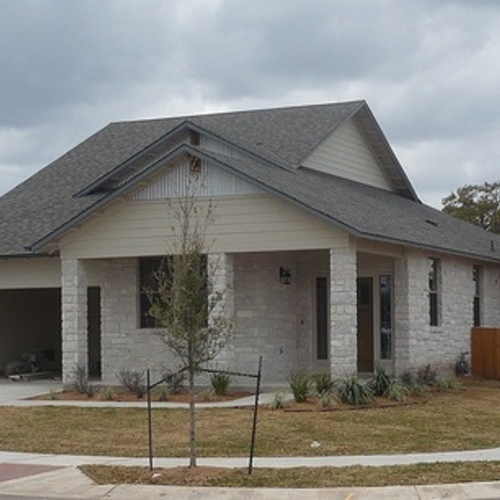
Image Credit: Martin Holladay
New Standard Competes With NAHB Guidelines and LEED for Homes
NEW YORK, N.Y. — The National Association of Home Builders (NAHB) and the International Code Council (ICC) have successfully shepherded a residential green building standard through the American National Standards Institute (ANSI) approval process. Known as the National Green Building Standard, or ICC-700, the document establishes, for the first time, a national definition for green residential building.
To comply with ANSI requirements, NAHB and ICC assembled a committee consisting mostly of builders, manufacturers’ representatives, and code officials. Using the 2005 NAHB Green Guidelines as a starting point, the committee solicited public comments and conducted four public hearings over two years. They broadened the standard to include site development, multifamily housing projects, and remodeling in addition to single-family homes. The fruit of the committee’s labors was approved as Standard ICC-700 in late January 2009.
Like LEED for Homes, the residential green building rating system developed by the U.S. Green Building Council (USGBC), ICC-700 has four compliance levels. While LEED for Homes calls its levels certified, silver, gold, and platinum, ICC-700 uses the terms bronze, silver, gold, and emerald.
The new standard includes a list of mandatory measures, most of which correspond to minimum code requirements. In addition, builders must accrue points by incorporating features in six areas: site development, water conservation, energy conservation, resource conservation, indoor air quality, and homeowner education. Houses over 4,000 square feet will need more points for a given certification level than smaller houses.
For bronze certification, a home must be designed to use 15% less energy than a home that minimally complies with the 2006 International Energy Conservation Code (IECC). To reach the emerald level, a home must achieve a 65% reduction in projected energy use. All houses must include a mechanical ventilation system complying with ASHRAE Standard 62.2.
Although energy compliance depends strongly on climate zone, most ICC-700 checklist points (including water-saving measures) apply nationwide. There are a few exceptions, however; as Don Carr, NAHB’s national green building certification program manager, pointed out, “The standard includes a termite zone map, a radon map, and rainfall map.”
Online Scoring Tool
The NAHB will continue to support builders who choose to rate homes using the less stringent 2005 Guidelines rather than the new ICC-700 standard. “There will always be two paths until one path disappears,” said Carr.
For builders seeking certification to a higher standard than the Guidelines, the NAHB Research Center has established a process to certify whether projects meet the new ICC-700. The first step is for builders to use NAHB’s free online scoring tool (www.nahbgreen.org/ScoringTool.aspx). “The scoring tool sets us apart from our competition,” explained NAHB division director Vladimir Kochkin. “It simplifies implementation. When you get a score, so you can see what level you qualify for. Then you can make changes; you can play around with it. If you decide to go for certification, you fill out an application, which is submitted to an outside NAHB-accredited verifier. The verifier will look at the information submitted. Then, to make sure that that the construction is consistent with the information in the application, the verifier will conduct two on-site inspections: a rough-in inspection and a final inspection.”
NAHB charges builders $500 per project for certification; the fee drops to $200 for NAHB members. In addition to the certification fee, builders will need to pay several hundred dollars for third-party verification.
Comparing Stringency
Since the ICC-700 standard is brand new, it will take a while for energy consultants to determine whether the standard is more or less stringent than LEED for Homes. “My opinion right now, subject to confirmation from additional study, is that the basic ICC-700 standard house will be very close to a LEED for Homes certified house,” said Bion Howard, an energy consultant from Valley Center, California. LEED takes a tougher line on certain divisive issues, however, such as certification of tropical woods.
According to Carr, “Compared to LEED for Homes, I think builders will find that NAHB’s green building standard is more flexible and usually less expensive to meet in terms of hard costs. And it is definitely less expensive to meet in terms of soft costs.”
When comparing the new standard with the old NAHB Guidelines, NAHB representatives are unequivocal. “The Standard is more stringent than the Guidelines,” said Carr. “The bar has been raised.” Kochkin agrees. “At the end of the day they ratcheted up the Standard compared to the Guidelines quite a bit,” said Kochkin. “The new Bronze corresponds more or less to the silver level in the Guidelines.”
Three Available Paths
Opinions differ on whether having three rating systems for new single-family homes — the 2005 NAHB Guidelines, the ICC-700 standard, and LEED for Homes — is confusing to builders. “I call it the Trifecta question,” said Howard. “I think the standard provides an agreed-upon floor upon which guidelines with a higher environmental purpose can be based. But now there are arrows pointing in three or four directions. That is a concern — what will happen in terms of harmonizing all this stuff?”
Brendan Owen, the vice president of LEED technical development at USGBC, sees no urgent need for harmonization. “I think that what NAHB has done and what LEED for Homes does are two different things,” said Owen. “We try to create rating systems that are leadership standards. We are working to create a mechanism that recognizes high-performance green building.”
The way forward, Howard suggests, involves dialog. “The time is right for USGBC to have a series of meetings with NAHB about harmonization,” said Howard. “If the purpose of these guidelines is to provide better information to consumers, then it behooves everyone to get on the same page.”
Prodded to consider the possibility of harmonization, Owen suggested a parallel between ICC-700 and ASHRAE 189. “One of the things we have done on the commercial construction side is to partner with ASHRAE to create standard 189, which is another type of minimum green building standard that seeks to establish a floor, that sets a new minimum,” said Owen. “If ASHRAE 189 evolves the way we hope it does, it could serve on the commercial side as a prerequisite for LEED. There is still a lot of work to do on 189 to see if the resultant document can serve that purpose, though. And we haven’t entered into any type of discussion with NAHB around that topic.”
NAHB Evolves
Howard points out that by definition, a standard differs from a description of best practice. “A standard like this describes the worst you can do and still build a building that people can agree is green,” said Howard. “Maybe you could say it’s light green.”
Howard has been encouraged by a shift in NAHB’s approach to standard development. “Five years ago, I was seeing some disturbing patterns,” said Howard. “Whenever there was any talk of developing a new standard, NAHB tended to be the 800-pound gorilla that dragged its feet all the time. But this doesn’t seem to have been happened with the development of this standard. NAHB appears to have made a decision to put together a reasonable standard and push it through the ANSI process.”
Weekly Newsletter
Get building science and energy efficiency advice, plus special offers, in your inbox.















2 Comments
NAHB's Evolution
It has been interesting to watch the evolution of NAHB regarding green building programs and standards over the last 7-8 years. Early on, they clearly stated that there would be no national green program, they were focused on promoting the guidelines to local associations and assisting them in creating their own local programs. Then one day, it seemed quite suddenly, they looked in the rear view mirror and saw LEED for Homes tailgating them with their brights on. Almost overnight, there was a shift to creating a national program, which they did in short order. Now they have the new standard, also developed quite quickly, which is, at least temporarily, competing with their own guidelines. I am told that certifying homes to the guidelines will eventually be phased out - one estimate is in the 18 month range. It is certainly a good thing that NAHB created what appears to be a solid green building standard, although I am sure that there will be lots of sniping all around - after all, why should everyone be polite all the time?
I continually am asked "which program will be the winner?" If I only knew that, I could probably figure out a way to turn that into a small fortune, but I am truly in the dark as to where this is going to end up. It will definitely be an interesting ride.
LEED-h vs NGBS ICC-700, is it really a contest?
I really don’t see LEED-h and NGBS as being in competition with each other.
LEED-h customers and their community look to LEED-h designers and builders for leadership in green building. The USGBC is the leader in the industry and is secure in its niche as the product of choice when building a truly exemplary structure at any price range.
But there is a real need for a green building program with training wheels on it. And that is where the NGBS (ICC-700) fits in, it reaches builders where they live, with a language that is clearly written and easy to understand, and it has a high potential for success with people who were building McMansions last year.
We’re all in this together, trying to change the way America builds and remodels, and as much as we need the leadership of generals and fighter pilots we also need an army of troops on the ground.
The three day NAHB Certified Green Practitioner course, which is trying to create that army, is like giving someone a drink with a fire hose. But in the end it’s the building, not the builder, that is getting the verification. The CGP designation just opens builders minds (and sharpens their business ethics in day three) so they can respond positively to the customer who wants to know more about incorporating green features into their new home or remodeling project.
I really believe that LEED-h and the NGBS (ICC-700) have the potential to be very complementary to each other.
Like the revival tent by the river and the brick church on the hill, they really don’t compete for the same audience
Log in or create an account to post a comment.
Sign up Log in